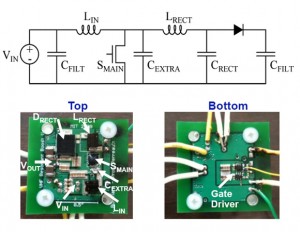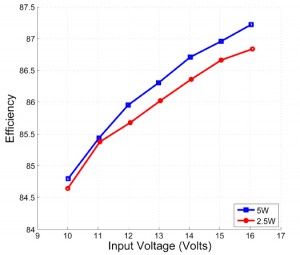Design of a Very-high-frequency Resonant Boost DC-DC Converter

Figure 1: Schematic and board photographs of the converter prototype. The converter operates with a nominal input and output voltage of 12 and 30 Volts, a switching frequency of 75 MHz, and a peak output power of 7 Watts.
Increasing the switching frequency of DC-DC converters has the benefits of requiring less passive energy storage and providing improved transient performance. However, typical converter circuits contain many loss mechanisms that grow with switching frequency and prohibit a drastic increase in frequency. This problem has been alleviated through the development of soft-switched resonant converter topologies that minimize frequency-dependent losses in the switching device by operating the converter with zero-voltage-switching and through the use of resonant gate drivers [1] [2] [3] [4]. With these losses minimized, the converter can then be operated fast enough to use air-core or low-permeability RF core inductors to avoid the frequency-dependent losses from high-permeability magnetic materials. This concept has been successfully demonstrated for boost conversion at frequencies up to 110 MHz using a resonant boost Φ2 converter topology in [4] [5] [6]. This work explores an alternative resonant boost converter topology that uses fewer passive components but suffers from a high peak drain-to-source voltage.

Figure 2: Measured efficiency (not including gate drive loss) vs. input voltage for two specified output power levels. Output power is controlled by on-off modulating the converter with a PWM signal at 1 MHz.
A design procedure for the proposed topology is developed that readily yields the necessary component values. This procedure – unlike previous design methodologies for similar topologies – is based on direct analysis of the topology and does not rely on lengthy time-domain simulation sweeps across circuit parameters to identify desirable design points. Furthermore, methods have been developed to find the optimal layout of the semiconductor switch for a particular converter design [7]. However, previous design methods for converters of this type have not been sufficiently simple that one can easily vary both the device layout and the converter design to find the best possible combination. The proposed design procedure enables this combined optimization yielding the rapid design of highly efficiency VHF DC-DC converters. To validate the design approach, a 75-MHz prototype converter is designed and experimentally demonstrated. The performance of the prototype closely matches that predicted by the design procedure and achieves good efficiency over a wide operating range.
References
- D.J. Perreault, J. Hu., J.M. Rivas, Y. Han, O. Leitermann, R.C.N. Pilawa-Podgurski, A. Sagneri, and C.R. Sullivan, “Opportunities and Challenges in Very High Frequency Power Conversion,” in 2009 IEEE Applied Power Electronics Conference, pp. 1-14, Feb 2009. [↩]
- J. Rivas, D. Jackson, O. Leitermann, A. Sagneri, Y. Han, and D. Perreault, “Design Considerations for Very High Frequency DC-DC Converters,” in Power Electronics Specialists Conference, 2006 PESC 06 37th IEEE, pp. 1-11, 18-22 June 2006. [↩]
- J. Rivas, R. Wahby, J. Shafran, and D. Perreault, “New architectures for radio-frequency dc/dc power conversion,” IEEE Transactions on Power Electronics, vol. 21, pp. 380-393, March 2006. [↩]
- R.C. Pilawa-Podgurski, A.D. Sagneri, J.M. Rivas, D.I. Andersion, and D.J. Perreault, “Very high frequency resonant boost converters,” in Power Electronics Specialist Conference Proceedings, June 2007. [↩] [↩]
- A.D. Sagneri, “Design of a very high frequency dc-dc boost converter,” Master’s thesis, Massachusetts Institute of Technology, Cambridge, MA, February 2007. [↩]
- R.C. Pilawa-Podgurski, “Design and evaluation of a very high frequency dc/dc converter,” Master’s thesis, Dept. of Electrical Engineering and Computer Science, Massachusetts Institute of Technology, Cambridge, MA, February~2007. [↩]
- A.D. Sagneri, D.I. Anderson, and D.J. Perreault, “Optimization of Transistors for Very High Frequency dc-dc Converters,” 2009 IEEE Energy Conversion Congress and Exposition, Sept. 2009, pp. 1590-1602. [↩]